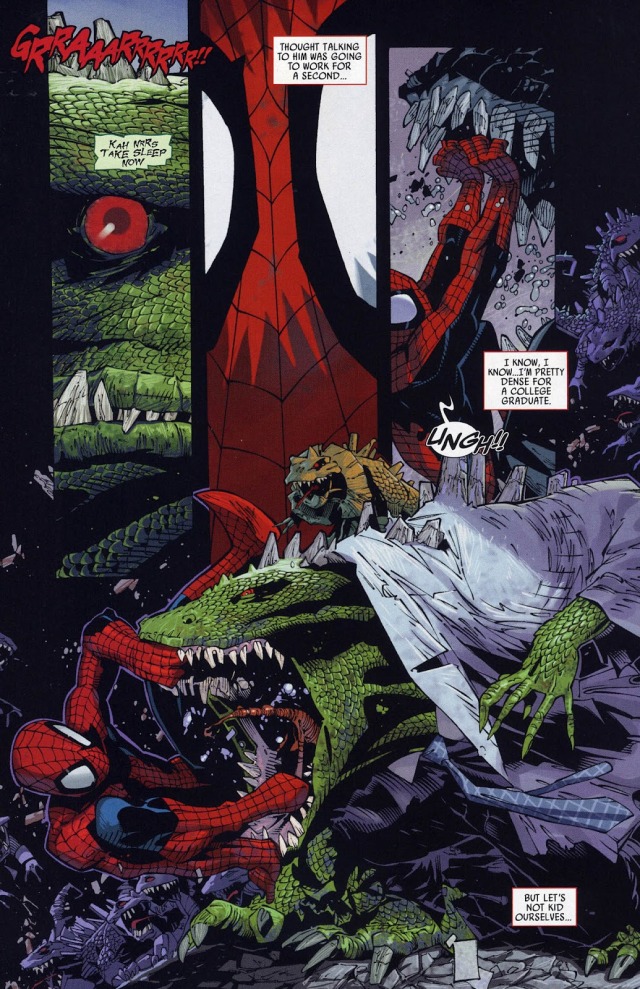In a series about the future of a character who exists primarily in a visual medium, I’ve written very little about the art. But that’s obviously something that anyone in charge of the Spider-Man comics is going to have to think about. While decisions about artists won’t directly restrict future creative teams, it’s something that often comes to define a particular era of the comics.
With the current schedule, which I do support, finding one steady artist for the book is almost impossible. If you want the same artist for every issue, you’re probably going to need to make Amazing Spider-Man a 20-22 page monthly again, which also excludes talented guys who don’t draw 22 pages a month (Marcos Martin, Lee Weeks, etc.) I don’t think that’s worth it.
An immediate question about the artistic direction is the degree to which the pencilers are expected to be similar. There are branding advantages to having a house style. But this is a character who can work in several different styles, so there are strong counterarguments for allowing more diversity.
I’ve been able to come up with four main types of Spider-Man artists. The first is Dynamic. I’d almost say this is the standard superhero art format. The people are generally handsome, and the fight scenes are usually bright and intense. John Romita Sr, Mike Wieringo and Mark Bagley would belong in this camp. They draw Spider-Man as a science hero.
The dynamic artist is the traditional superhero artist. You could imagine the guy doing very well on a standard Superman book. Case in point: Ross Andru’s work in the Superman/ Spider-Man crossover.
There can be variety within the category. Usually painted comics fall under this group, even when the setting seems more appropriate for a different type of artist, as in this scene from Paolo Rivera’s Spectacular Spider-Man #14.
The second kind of Spider-Man artist is Street-Level. These are the guys who seem to be a better fit for drawing Batman than Superman. There’s a more down-to-earth quality, even in the superhero slugfests. 21st Century John Romita Jr. and Lee Weeks would fit in this group.
If there are multiple Spider-Man monthlies, it can be useful to give the books separate identities by featurings different species of artists. The dynamic/ crime drama divide was explicit in the 1998 relaunch, when Amazing Spider-Man with John Byrne was the book with the science hero aspects of the character.
Meanwhile, Peter Parker Spider-Man with John Romita Jr. was the street-level title. Both titles were written by Howard Mackie and crossed over several times. But the demarcation was largely successful.
The third classification of Spider-Man artists would be Ditkoesque. I use that term, because I’m having trouble coming up with a better name for the style of Steve Ditko and those he influenced. There’s a clean sometimes cartoony style, although the layouts and perspectives could be quite unconventional. Storytelling remains paramount. Examples of those following in Ditko’s footsteps would include Marcos Martin, Mike Allred and Javier Pulido.
One interesting thing about the Spider-Man comics is that the first artist wasn’t in the traditional dynamic category. Ditko was in a class of all of his own.
Of course, it’s worth remembering that Amazing Spider-Man became Marvel’s best-selling title under John Romita Sr. When Ditko was on the book, it was outsold by Lee and Kirby’s Fantastic Four. That’s obviously nothing to be ashamed of, but it suggests an advantage of the traditional over the off-beat.
The final art category would be Weird. Clarity of storytelling isn’t as important as conveying a particular mood. Usually it’s a horror-inspired tone, with the oddity of the pencils reflecting the strangeness of what’s going on to the characters. These are the guys who are more likely to do side-projects than to draw Amazing Spider-Man. Chris Bachalo, Paul Pope and Ted McKeever would fit into this category, which arguably includes Todd Macfarlane’s solo work on Spider-Man. These artists may also be referred to as “highly stylized.”
While the major reason for “weird” art is to convey horror or an unusual menace, it can also be done for humor, as in Eric Canete’s work in Amazing Spider-Man #611.
A few Spider-Man pencillers could fit into several of these categories, especially at different points of their careers. Ramos seems to be more of a dynamic artist when he’s on Amazing Spider-Man, although he was much more comfortable as a “weird” artist when he worked with Paul Jenkins.
Amazing Spider-Man has had about twelve artists since the Brand New Day era began, and a few more have been announced. This does raise a lot of questions for the people in charge, as well as Spider-Man fans. Presumably, we all want competent artists. And we don’t want rush jobs with multiple artists on the same issue. But, how much does it matter if the main stories in a trade paperback are in the same “style?” Would it bother you if a trade paperback has a two issue storyline by Adi Granov, followed by three issues by Javier Pulido and a single issue by Eric Canete? If you prefer that the series generally have one “house” style, what type of exceptions would you allow?
I don’t care that much about having a consistent style. I could understand trying to preserve artistic consistency on the book if Amazing Spider-Man were just one of several monthly titles. But at the moment, it seems like too restrictive an approach for a character that can work in so many different methods.













